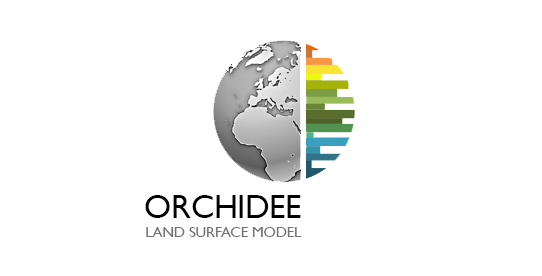| 1 | Reconstruction of the historical PFT maps is done with the following steps: |
|---|
| 2 | |
|---|
| 3 | 1. Aggregation of the ESA CCI land cover data for 2010 into generic PFT map (0.25 degree resolution, 15 PFT classes), using: |
|---|
| 4 | - ESA CCI land cover map for 2010 (v2.0.7b, 300 meters resolution, 38 land cover classes) |
|---|
| 5 | - aggregation tool "lc-user-tools" (v3.13) |
|---|
| 6 | - additional Koeppen-Geiger climate zone map |
|---|
| 7 | - default cross-walking table (v2.4), matching ESA CCI classes with generic PFT classes |
|---|
| 8 | - additional cross-walking table (v2.4), refining the conversion of several ESA CCI classes depending on the climate zone |
|---|
| 9 | |
|---|
| 10 | 2. Aggregation of the generic PFT classes for 2010 into 15 ORCHIDEE PFTs plus 4 additional classes (urban, inland water, coastal water, permanent snow/ice), using: |
|---|
| 11 | - python script "CCI_to_PFT19.py" |
|---|
| 12 | - additional partitioning C3/C4 vegetation map (Still et al., 2009) |
|---|
| 13 | - Earth surface topography data at 5 minute resolution (ETOPO5.nc) |
|---|
| 14 | |
|---|
| 15 | 3. PFT map reconstruction for by merging ORCHIDEE PFT map for 2010 with LUH2v2h or scenarios data: |
|---|
| 16 | One want to use LUHv2 for the evolution of crops and pasture lands. On the other side, one want to benefit of the ESA map for defining PFT mosaic within each PFT. Based on reference year (here we use 2010), we substract the fractions of the LUH2 that we identify as managed to the fractions of crops and grasslands in the ESA map. The remaining land fractions in Ethe SA map are assumed to correspond to the mosaic of vegetation which forms the natural lands of each tile. From this. This PFT fractions related to the natural land is then used to split, each year, the total lands of LUH2 corresponding to the sum of Primary forested land, Primary non-forested land, Secondary forested land and Secondary non-forested land. The remaining vegetation classes from LUH2 are more easily allocated into C3 grass, C4 grass, C3 crop and C4 crop. C3/C4 grass split uses the information contained into the ESA map. |
|---|
| 17 | |
|---|
| 18 | For historical period (850-2014), use of the following script and data |
|---|
| 19 | - ferret script "process_landusemap_19PFT_quarterdeg_final_temp.jnl" |
|---|
| 20 | - LUH data : /home/basc/dnarayan/LandUsemap_ORCHIDEE/LUH2v2h/states.nc : they are the same than those stored on input4mip |
|---|
| 21 | - ESA: /home/satellites7/vbastri/LC/orchidee/ESA2.0.7b/19PFT_quarterdeg_final/PFTmap_2010.nc |
|---|
| 22 | |
|---|
| 23 | For the scenarios (2015-2100) |
|---|
| 24 | - process_landusemap_19PFT_quarterdeg_final_temp_future.jnl : generation of a reference map for year 2010 with the PFT fractions corresponding to the natural vegetation (fractions_from_ESA2.0.7b_19PFT_quarterdeg_PFTmap_2010.nc). This is the same that the one used internally in the script process_landusemap_19PFT_quarterdeg_final_temp.jnl for the historical period. |
|---|
| 25 | - process_landusemap_19PFT_quarterdeg_final_temp_future_2dstep.jnl : generation of the land-use map for a specific scenario given as argument to the script (for instance, AIM-ssp370-2-1-f or GCAM-ssp434-2-1-f) |
|---|
| 26 | - ScenarioMIP data : states variables for the different scenarios (SSP-RCP) stored under /home/surface7/vuichard/LandUseMap_CMIP6/(they are the same than those stored on input4mip) |
|---|
| 27 | - ESA: /home/satellites7/vbastri/LC/orchidee/ESA2.0.7b/19PFT_quarterdeg_final/PFTmap_2010.nc |
|---|
| 28 | |
|---|
| 29 | |
|---|
| 30 | 4. Post-processing of the historical maps (adding inland water as bare soil; extension of land points into the ocean by 8 pixels; formatting netcdf-files according to ORCHIDEE requirements), using: |
|---|
| 31 | - python script "post_PFT.py" |
|---|
| 32 | |
|---|
| 33 | ESA CCI land cover data can be found at https://www.esa-landcover-cci.org/ |
|---|
| 34 | All other used data and tools can be found in PFTMAPS/SOURCE directory |
|---|
| 35 | To run python scripts Python 2.7 or higher with numpy and netCDF4 libraries is required |
|---|
| 36 | For additional information please visit https://orchidas.lsce.ipsl.fr/dev/LCCCI.php |
|---|
| 37 | |
|---|
